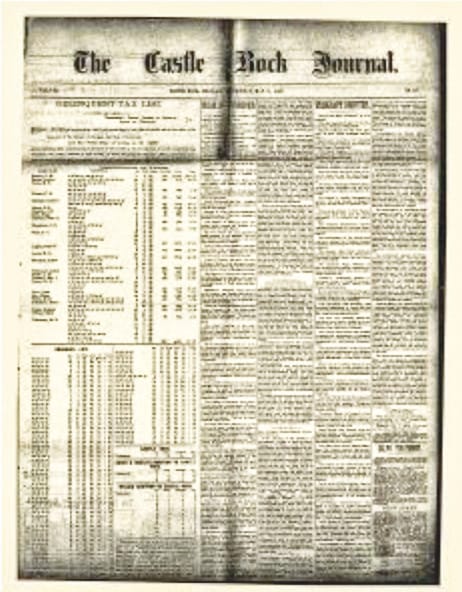A milling town gone coaled


By Joe Gschwendtner; photo courtesy of Newspaperarchive.com

A glimpse of The Castle Rock Journal newspaper from Wednesday, May 11, 1887
People and towns came and went in the early days of statehood. Had it not been for an obscure notation on a map, the once thriving town of Lehigh would have been a forgotten Wildcat town.
In 1878, coal was a valuable commodity in an industrializing world. When coal deposits were linked with Stephen O’Connell’s homestead west of Sedalia, word of his valuable mineral rights spread quickly. When offered the princely sum of $10,000 in 1880 for his landholdings by A.S. Whittaker and C. E Warren, O’Connell took the deal.
When Warren and Whittaker later formed the Denver Coal Company (DCC), profiting dramatically on the quick sales of personally-owned stock, O’Connell took to the courts claiming the stock was fraudulently obtained. Despite starting out with legal troubles, the Lehigh mine’s future looked good and the main shaft was widened and deepened to 200 feet.
The court proceedings and thin capitalization put DCC in jeopardy. Enter James Cannon Jr., recognizing an opportunity ripe for profit. He lent DCC $7,500, securing the debt with company ownership. When the loan later proved insufficient to salvage company operations, Cannon purchased all of the mineral rights, the town itself and surrounding land for a mere $8,000 more.
By 1882, Lehigh was prospering, quite enough to warrant construction of a 4.6 mile narrow gauge railroad spur of the Denver & Rio Grande Railroad from Louviers. As an inducement, Cannon made financial commitments to vendors with the track extension, but later could not meet them. To allow DCC to survive again, he took Whittaker and Elmworth Still in as additional shareholders. Collectively they infused $60,000 which proved to be the capital boost needed. Lehigh would reach a population of 1,000 residents and produce 75 tons of coal a day by December 1883.
But a backstory always seemed to rage above ground. While O’Connell made another attempt to reclaim his land, George Bates, attorney who defended DCC, was not paid for his services. He would slap a lien on the company until his debt was discharged. The miners went on to participate in a wide-ranging coal miners’ strike in Colorado in late 1884. This dispute caused crippling friction within the mining community as non-union workers were called in to help.
When the strike ended, DCC was beset by individual lawsuits and hard feelings. By 1887, Lehigh was in deep trouble. A news piece on May 11, 1887 in The Castle Rock Journal brimmed with unwarranted optimism, talking up the efforts of James Cannon as a man of “pluck, energy and perseverance,” predicting a “bright future for Lehigh and its projector.” Too little, too late.
When the Denver & Rio Grande Railroad demolished the spur line in 1890, Lehigh had been reduced to quarrying limestone and a population of less than 100. By 1893, the town and land ownership was acquired by William Lambert of Sedalia. He would later use the lumber from dismantled Lehigh for snow fences in his Sedalia orchards.
Wildcat Lore
As it turns out, The Connection serves residents of the Wildcat Mountains, a name pioneers and historians gave to the high country paralleling I-25 from Highlands Ranch and Lone Tree south to Castle Rock. Since the first territorial road (Daniels Park Road) bisected our mountains, there was no shortage of colorful characters parading through what are now private properties on the ridges of Douglas County. We bring these grizzled and gutsy settlers alive again, vividly sharing their stories of grit and achievement in these Castle Pines.